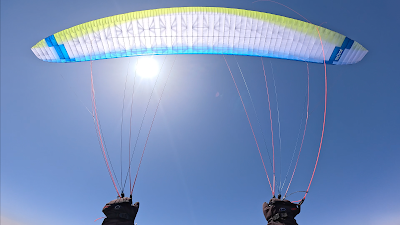Hi,
This is my first video with the GTO 3. I hope you will like it.
More videos on that beautiful glider, hopefully later.
👀 Useful links ! ALWAYS UPDATED ! 🍀
Friday, May 23, 2025
GIN GTO 3 (Video)
Thursday, May 15, 2025
NEARBIRDS Zippy 3
Nearbirds Zippy 3 Light XC harness.
Nearbirds has its unique touch when creating paragliding harnesses. The Zippy 3 is some kind of a lighter, the light version of already light Airy Vibe, with an ABS adjustment option.
That harness resembles the Airy Vibe, but lighter. The straps are sturdy for high durability and strength. If you want a light harness but durable for hike and fly, XC, a travel companion, the Zippy 3 offers that solid package. The comfort inside that Zippy 3 highly resembles the Airy Vibe. Lots of straps for adjusting to the perfect comfort. I feel more (safer under a large strap harness! Maybe it's just me…But it seems to send reassuring informations to my head that I can often play around throwing 360’s, wing overs, with that psychological feel…you know what I mean if you have flown minimalistic super light harnesses, that are also considered very safe and strong…but its perhaps my head playing me around, saying to me: That’s a light harness but OK!
The comfort on this L size, or the back and hips, is nice for my body configuration and height of 1.81 and 74 kg. The legs are naturally supported. I can reach the zipper on the front side of the cockpit to reach my instruments or stuff inside. A water release tube can be inserted. A camel water on the bag, two pockets on each side for your drag chute. A large pocket for the rescue system, I have already installed a medium (105 kg GIN rescue) that is relatively horizontally large, but fits nicely.
The roll movements are moderate, even if the ABS is released. When you tighten the ABS, the roll is slightly more stable, like on the NK Arrow harness. Much more stable than a WV GTO light 2, as you have the authority of control under the Zippy 3. Both are quite different in their underlying feel. The GTO 3 light and the Lightness 2 are very close in stability. The Zippy 3 joins the NK Arrow for roll feel.
Two large open side pockets near the chest strap for any stuff, gloves, chocolate, etc… The only thing I wish to receive with the harness is a small line with a small ball, to clip on my shoe lace in order to get swiftly inside the pod, since the pod closes laterally. I just installed one in 30 seconds! No worries about that. You can also do it easily, and I think it's better.
The Zippy 3 doesn’t have a seat bird, but Nearbirds installed a kind of frame on the edge of the seat that gives the seat board a feel, and I thought there was a seat board when flying it. Overall, it's efficient to control it with your thighs in turbulence.
Here's a small video: https://www.youtube.com/watch?v=ltxeLg1voaM&t=5s
Happy and safe flights,
Ziad
Wednesday, May 14, 2025
NOVA Vortex XS, Light 2 liner EN-C
NOVA Vortex XS, Light 2 liner EN-C
Tuesday, May 13, 2025
BGD Base 3 M
BGD Base 3 M




